
The genus Pulsatilla contains about 40 species of herbaceous perennial plants native to meadows and prairies of North America, Europe, and Asia. Derived from the Hebrew word for Passover, "pasakh", the common name pasque flower refers to the Easter (Passover) flowering period, in the spring. Common names include pasque flower, wind flower, prairie crocus, Easter flower, and meadow anemone. Several species are valued ornamentals because of their finely-dissected leaves, solitary bell-shaped flowers, and plumed seed heads. The showy part of the flower consists of sepals, not petals.

Androsace, commonly known as rock jasmine, is a genus of flowering plants in the family Primulaceae, second only to Primula in the number of species. It is predominantly Arctic–alpine, with many species in the Himalayas, the mountains of central Asia, the Caucasus, and the southern and central European mountain systems, particularly the Alps and the Pyrenees.

Orobanchaceae, the broomrapes, is a family of mostly parasitic plants of the order Lamiales, with about 90 genera and more than 2000 species. Many of these genera were formerly included in the family Scrophulariaceae sensu lato. With its new circumscription, Orobanchaceae forms a distinct, monophyletic family. From a phylogenetic perspective, it is defined as the largest crown clade containing Orobanche major and relatives, but neither Paulownia tomentosa nor Phryma leptostachya nor Mazus japonicus.
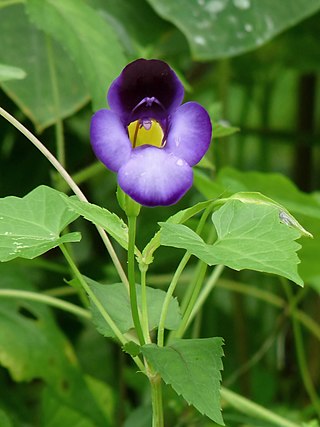
Torenia is a genus of plants now classified in the family Linderniaceae. Torenia has also been classified in the figwort family Scrophulariaceae. Often called wishbone flowers, bluewings; in Hawaii nanioola'a or ola'a beauty, some species are grown as garden plants. Many F1 and F2 Torenia hybrids have been hybridized in the last 30 years. Colors can range from white with yellow throats to violet, blue, cobalt, lavender and purple.

Linderniaceae is a family of flowering plants in the order Lamiales, which consists of about 25 genera and 265 species occurring worldwide. Vandellia micrantha is eaten in Laos, but tastes bitter. Best known are the wishbone flowers Torenia fournieri and Torenia thouarsii, which are used as bedding plants, especially in the tropics. Micranthemum is sold as an aquarium plant when it is called 'baby tears'.
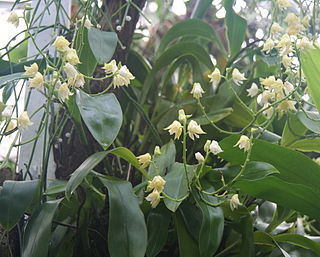
Polystachya, abbreviated Pol in horticultural trade, and commonly known as yellowspike orchid, is a flowering plant genus in the orchid family (Orchidaceae). This rather distinctive genus was described by William Jackson Hooker in 1824 and is the type genus of the subtribe Polystachyinae. It contains about 100 species widespread across many of the tropical areas of the world.
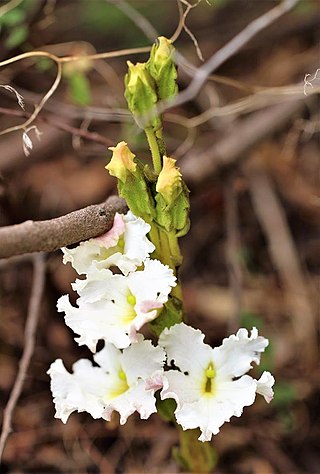
Harveya is a genus of parasitic plants in the family Orobanchaceae. The approximately 29 species included are native to Africa from Eritrea to South Africa, Madagascar and the Mascarene Islands, the Arabian Peninsula, and Turkmenistan in Central Asia. In South Africa they are commonly known as 'inkblom', because early settlers used the flowers to make ink, and this is the source of the English common-names for the genus of ink flower or ink plant.
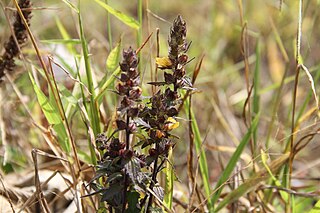
Alectra is a genus of flowering plants in the family Orobanchaceae. It comprises hemiparasitic species which occur in tropical and southern Africa, including Madagascar, and tropical and subtropical Asia.

Microtea, the jumby peppers, are a genus of flowering plants in the family Microteaceae, native to the Caribbean islands, Central America, and tropical South America.
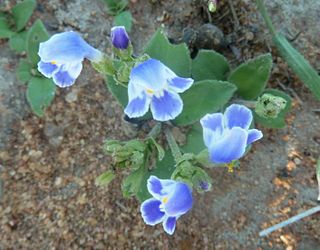
Craterostigma is a genus of shrub-like flowering plants in the family Linderniaceae, found in Africa, Madagascar, Socotra, the Arabian Peninsula, the Indian Subcontinent, Sri Lanka, China, Southeast Asia and Java. The best studied species is the resurrection plant Craterostigma plantagineum, known for its unique drought tolerance.
Bardotia is a genus of flowering plants belonging to the family Orobanchaceae.
Crepidorhopalon is a genus of flowering plants belonging to the family Linderniaceae.
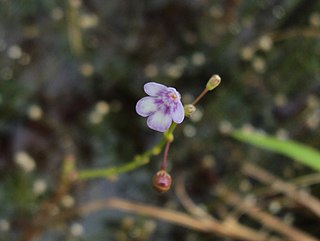
Dopatrium is a genus of flowering plants belonging to the family Plantaginaceae.
Micranthemum is a genus of flowering plants belonging to the family Linderniaceae.
Sopubia is a genus of flowering plants belonging to the family Orobanchaceae.
Hartliella is a genus of flowering plants belonging to the family Linderniaceae.
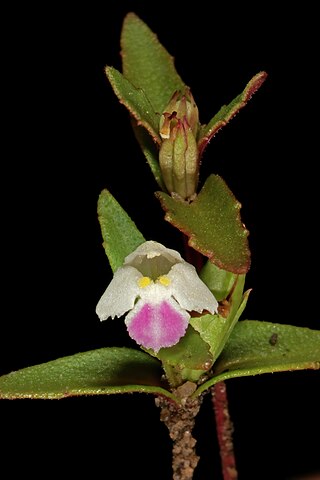
Linderniella is a genus of flowering plants belonging to the family Linderniaceae.
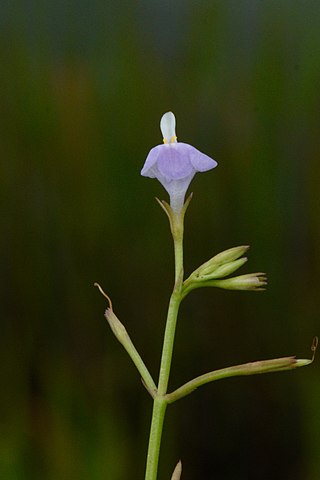
Bonnaya antipoda is a herbaceous perennial plant belonging to Linderniaceae family. It is native to tropical and sub-tropical Asia and Australia.












